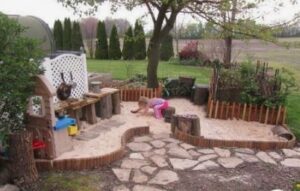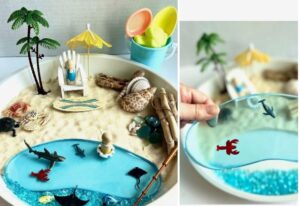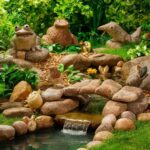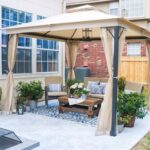Outdoor playscapes for kids can include swing sets, playhouses, and climbing walls. These structures encourage exploration, play, and imagination.
They provide entertainment and help develop essential skills in a fun way. With endless possibilities, outdoor play areas offer a world of adventure for children to enjoy.
Key Takeaways
- Nature-inspired play areas
- DIY obstacle courses
- Sensory bins and water play areas
- Play structures for physical and cognitive development
- Outdoor games for fun and social interaction
Swing Sets and Slides
Swing sets and slides are great for outdoor fun in your backyard. They keep kids active and entertained without having to go to the park all the time. Swing sets and slides come in different sizes for different ages.
Smaller sets with gentle slides are perfect for toddlers, while older kids can enjoy bigger sets with more challenging slides. These structures provide a designated space for fun and creativity.
Kids can swing high or zoom down a slide, promoting physical activity and imaginative play right at home.

Playhouses and Treehouses
Playhouses and treehouses give kids special spaces to have fun and use their imagination. Playhouses have things like kitchens and furniture for pretend play, while treehouses can be decorated with lights and cool designs tailored to what kids like.
To make these spaces even more fun, you can add old pots. These pots can be turned into magical cauldrons for making pretend potions, used as cooking tools for make-believe play, or even used as planters for a small garden in the play area. Kids can use the pots in different ways to make their playtime more exciting and imaginative.

Climbing Walls and Ropes
When setting up climbing walls and ropes, make sure they’re installed properly and supervise kids closely for safety.
Encourage children to challenge themselves and build strength and problem-solving skills.
Get creative with wall designs to keep kids engaged and excited about this fun activity.

Safety in Climbing
When kids climb on walls and ropes, make sure everything is securely anchored and use helmets and harnesses for safety. Check these structures regularly for any dangers.
Always have adults supervise children to avoid accidents. Teach kids the right way to climb and follow safety rules.
Benefits of Ropes
Climbing ropes help kids get stronger and more coordinated. They’ve had fun climbing and swinging on these ropes, which also helps them work out their muscles and improve their skills.
Ropes on climbing walls challenge kids to solve problems and be aware of their surroundings. By including ropes in play areas, children can practice being agile, balancing, and using their hands and fingers in a cool way.
Playing with ropes sparks creativity and imagination, making climbing a fun adventure outdoors. It’s a great activity for kids of all ages to enjoy and benefit from.
Wall Design Ideas
Adding climbing walls and ropes to outdoor play areas can help kids have fun while also improving their physical skills like coordination, balance, and muscle strength. These elements provide a challenging and engaging experience that promotes problem-solving and confidence.
Mud Kitchens and Sandboxes
To set up a mud kitchen, you’ll need old pots and pans.
Sandboxes are great for kids to play in and develop their fine motor skills.
These outdoor play areas help children explore, build, and interact with others.
They also stimulate senses and creativity, boosting cognitive development.
Mud Kitchen Benefits
Mud kitchens in outdoor play areas help kids play with mud and water, which lets them feel different textures and materials. This kind of play sparks creativity and imagination in children.
It also helps them interact with others, improving their communication skills. Getting messy in a mud kitchen can help kids think better and solve problems.

Sand Play Ideas
When setting up sand play areas for kids, you should include sandboxes, which are timeless play features loved by children of all ages. Sand play helps improve hand-eye coordination and dexterity, while also encouraging social interaction and imaginative play.
Playing in the sand can be calming and promote sensory development, similar to the benefits of mud kitchens. Additionally, sand play fosters creativity and imagination in children.
Outdoor Sensory Fun
Sandboxes and mud kitchens are great for kids to play outside and learn through their senses. Sandboxes help kids improve their hand-eye coordination, fine motor skills, and spatial awareness by playing with the sand.
On the other hand, mud kitchens allow children to explore natural materials like mud, water, and plants, connecting them to nature. These outdoor activities are fun and help kids develop important skills while having a good time.
Setting up a sandbox or mud kitchen in your backyard can provide endless opportunities for creative play and outdoor exploration. Playing in a sandbox not only brings joy to children but also helps with their thinking, emotions, and social skills in a natural and playful way.
Sensory Bins and Water Play
Children can have fun and learn through sensory play with water activities in outdoor areas. They can enjoy playing with colored water, floating toys, and sensory bottles made from recycled water bottles. Setting up a water wall using old bottles can encourage exploration with water flow.
Including elements like sand, rocks, and plants in outdoor play areas provides a diverse sensory experience. Creating sensory garden paths can stimulate different senses and create a relaxing environment for kids to explore. These activities help children develop their senses and learn in an engaging way.

DIY Obstacle Courses
You can use cones, ropes, hula hoops, tires, and pillows to create a fun obstacle course for kids in your backyard.
Cones mark boundaries, ropes for jumping or crawling, hula hoops for stepping through, tires for balancing, and pillows for soft landings.
These items help kids improve their motor skills and stay active while playing outdoors.
Nature-Inspired Play Areas
Nature-inspired play areas are special because they use natural materials like wood and stone. They have water features like streams or fountains, attract wildlife with plants, offer natural light and shade, and include swing sets made from wood.
Kids can play and explore in these spaces while feeling connected to nature.
Outdoor Games and Activities
Outdoor games for kids are a great way to have fun and stay active. They help kids develop important skills like problem-solving and teamwork. Here are some game ideas you can try:
- Obstacle Course: Create a fun course with obstacles for kids to navigate through.
- Water Balloon Toss: A cool game for hot days where kids toss water balloons to each other.
- Sensory Scavenger Hunt: Encourage kids to explore nature using their senses.
- Simon Says: Test listening and coordination skills with this classic game.
These games aren’t only enjoyable but also promote physical activity and social interaction. So, get outside and have a blast playing these games in the sun!
Creative Play Structures and Designs
Outdoor games and activities for kids focus on creative play structures and designs that help in physical and cognitive development. Here are five important elements of these play structures:
- Climbing walls and ziplines promote physical activity and develop motor skills.
- Nature-inspired elements and water features engage the senses, connecting kids to the environment.
- Adventure trails and interactive digital elements inspire creativity in children.
- Inclusive design features ensure children of all abilities can enjoy the play structures.
- Play structures offer educational experiences in STEM activities, environmental awareness, and cultural themes for holistic learning.
Frequently Asked Questions
How Can I Make My Playgrounds More Fun?
To make your playgrounds more fun, consider adding things like climbing walls, slides, swings, and themed play areas. It’s important to have different spaces for different activities and include cool structures for kids to explore.
How Do You Build an Outdoor Play Area for Kids?
When building an outdoor play area for kids, consider the space and the children’s ages. Choose safe and fun equipment suitable for their age. A sandpit can be a great addition to playtime. Remember to supervise, maintain, and regularly check for safety.
How do you design an outdoor playground?
Create a playground with wheelchair ramps, sensory play areas, and natural materials. Ensure safety, educational opportunities, and creative spaces for all kids to have fun and learn.
How Do You Make a Natural Playscape?
To create a natural playscape, gather logs, rocks, and branches. Include sand, water, and plants for a sensory-rich experience. Design areas resembling forests or beaches for imaginative play. Use non-toxic materials and age-appropriate challenges for safety.
Conclusion
In conclusion, setting up a fun outdoor play area for kids with swings, playhouses, climbing walls, and sensory bins is a great way to get them moving and using their imagination.
It’s important to choose activities that match your child’s interests and abilities, and always make safety a top priority.
With a bit of creativity and effort, you can create a space where kids can have endless fun, learn, and enjoy the outdoors.











